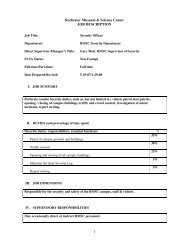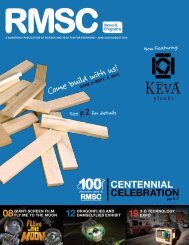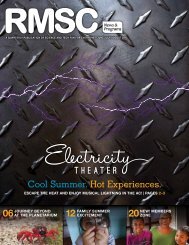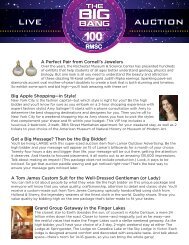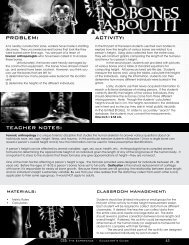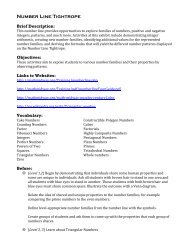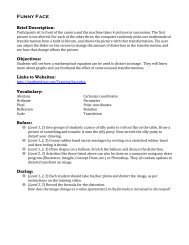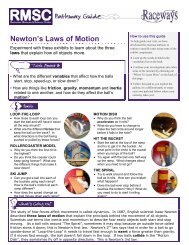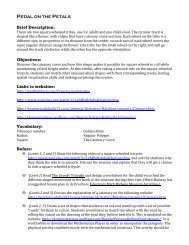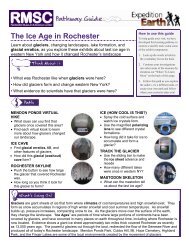Close Reading Protocol
Close Reading Protocol
Close Reading Protocol
Create successful ePaper yourself
Turn your PDF publications into a flip-book with our unique Google optimized e-Paper software.
<strong>Close</strong> <strong>Reading</strong> <strong>Protocol</strong><br />
Overview: These steps for close reading are specifically tailored for digging deeply into short passages of<br />
complex text. The complexity may arise from challenging lexile levels in relation to your students’ readiness,<br />
from figurative language or abstract concepts, from unusual organization or structure, and/or from the<br />
complexity of the ideas within the text selection.<br />
Process and Scaffolding: This protocol may be chunked into smaller steps and spread over several days,<br />
especially the first time it is introduced to students. Each section has unique learning demands and requires<br />
prior skills in word attack strategies, using context clues, and annotating text. Students will benefit from<br />
teacher modeling of each part, practice time, and re-teaching before putting all the pieces together.<br />
Gradually release the steps to students, providing less guidance and increasing their independence.<br />
Steps:<br />
1. <strong>Reading</strong> #1: Getting to know the text<br />
Read the selection, silently or aloud based on preference and need. The purpose for this first reading is<br />
to enjoy the selection, to get a general sense of its flow and ideas, and to build fluency.<br />
2. <strong>Reading</strong> #2: Capturing the gist<br />
Re-read the selection individually or guided by teacher modeling, depending on student need. The<br />
purpose of this reading is to locate the most important information by building on what you know and<br />
making connections to unfamiliar words and phrases to make meaning.<br />
• Beginning with the first sentence, underline what you know and summarize the ideas with<br />
annotation above the line of text. Circle unfamiliar words or phrases. Continue through the first<br />
paragraph.<br />
• State the gist or central idea of the paragraph in your own words. Write it as a short phrase in the<br />
margin.<br />
• If you cannot decipher the gist,<br />
a. Return to any unknown vocabulary and<br />
o For students who can read the words with fluency, use the five steps for context clues to<br />
uncover meaning (see below).<br />
o For students who cannot read the passage, begin with word attack strategies and then<br />
move to context clues if needed (see below).<br />
b. Consult a resource (dictionary, guide to using context clues, etc.) if necessary.<br />
c. Re-read the paragraph and follow the steps for capturing the gist again.<br />
• Ink-pair-share concept summaries: First rewrite the passage in your own words, sentence by<br />
sentence. Share your translation with a partner. Partners checks off each concept in the selection as<br />
they hear it re-phrased. Switch roles and repeat.<br />
• Together, pairs may create a concept map of the selection, showing how ideas are inter-connected<br />
and developed in the text. Model this as needed for students.<br />
• If there is confusion on any section, repeat steps a-c above.<br />
L. Newman – June 2012 1
3. <strong>Reading</strong> #3: Teacher frames this stage with rich, evidence-based text-dependent questions that students<br />
focus on during this reading. This question may be centered on developing inferences or asking their<br />
own questions to dig for deeper information/ uncover assumptions and analyze arguments in the text,<br />
or it may be content-specific for building and expanding background knowledge.<br />
• Students re-read targeted sections of the text and complete recording forms that drive at the textdependent<br />
questions.<br />
• Share with a partner, noting areas of agreement and differences.<br />
• Share with whole group using a sharing or discussion protocol based on purpose and preference.<br />
5 Steps for Using Context Clues<br />
Step 1: Check for synonyms or definitions embedded right there. If you find one, reread the sentence with<br />
the new term keeping the synonym or definition in mind. Then tell yourself in your own words what the<br />
sentence is saying.<br />
Step 2: Check for a contrast clue. If you find one, think about its meaning, telling yourself the opposite<br />
meaning. Then reread the sentence and rephrase it in your own mind.<br />
Step 3: When you read a sentence that you have trouble understanding because of an unfamiliar word,<br />
reread the sentence and substitute a word that seems to make sense in the context.<br />
Step 4: Read on. If the word you substituted does not make sense in the context of the rest of the<br />
paragraph, try again.<br />
Step 5: If the sentence still does not make sense to you and you do not understand the main point, look for<br />
a synonym, definition, and contrast clue. If you are still uncertain, check a dictionary.<br />
Word-Attack Strategies: Digging Into Problem Areas<br />
Word-attack strategies help students decode, pronounce, and understand unfamiliar words, using all three<br />
cueing systems. They help students attack words piece by piece or from a different angle.<br />
• Use Picture Clues<br />
- Look at the picture.<br />
- Are there people, objects, or actions in the picture that might make sense in the sentence?<br />
• Sound Out the Word<br />
- Start with the first letter, and say each letter-sound out loud.<br />
- Blend the sounds together and try to say the word. Does the word make sense in the sentence?<br />
• Look for Chunks in the Word<br />
- Look for familiar letter chunks. They may be sound/symbols, prefixes, suffixes, endings, whole<br />
words, or base words.<br />
- Read each chunk by itself. Then blend the chunks together and sound out the word. Does that word<br />
make sense in the sentence?<br />
• Connect to a Word You Know<br />
- Think of a word that looks like the unfamiliar word.<br />
L. Newman – June, 2012 2
- Compare the familiar word to the unfamiliar word. Decide if the familiar word is a chunk or form of<br />
the unfamiliar word.<br />
- Use the known word in the sentence to see if it makes sense. If so, the meanings of the two words<br />
are close enough for understanding.<br />
• Reread the Sentence<br />
- Read the sentence more than once.<br />
- Think about what word might make sense in the sentence. Try the word and see if the sentence<br />
makes sense.<br />
• Keep <strong>Reading</strong><br />
- Read past the unfamiliar word and look for clues.<br />
- If the word is repeated, compare the second sentence to the first. What word might make sense in<br />
both?<br />
• Use Prior Knowledge<br />
- Think about what you know about the subject of the book, paragraph, or sentence.<br />
- Do you know anything that might make sense in the sentence? Read the sentence with the word to<br />
see if it makes sense.<br />
References<br />
Kintsch, E., & Hampton, S. (2009). Supporting cumulative knowledge building through reading. In Parris, S., Fisher,<br />
D., & Headley, K. (Eds). Adolescent literacy: Effective solutions for every classroom. (47-57). The<br />
International <strong>Reading</strong> Association.<br />
Longman Vocabulary Website. (2010). Using context clues review. Retrieved from<br />
http://scc.losrios.edu.<br />
<strong>Reading</strong> A-Z. (n.d.). Word Attack Strategies. Retrieved from<br />
http://www.readinga-z.com/more/reading_strat.html#wordattack.<br />
L. Newman – June, 2012 3




